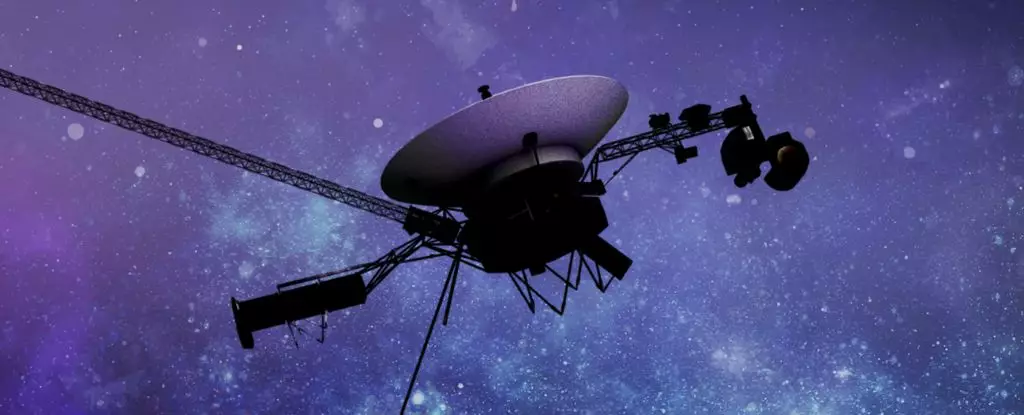In a remarkable demonstration of both human achievement and the challenges of long-distance space exploration, NASA’s Voyager 1 recently faced a brief communication blackout while traversing the vastness of interstellar space. This incident serves as a reminder of the intricate balances that exist in spacecraft technology and operations. Voyager 1, the furthest human-made object from Earth, at a staggering distance of approximately 25 billion kilometers (15.3 billion miles), experienced a notable malfunction stemming from a seemingly benign request made by mission control. A command sent on October 16 asked the spaceship to activate one of its heaters, but instead of complying, Voyager 1 ceased communication for two full days, initially leaving the agency perplexed.
The time lag in communication can be attributed to the immense distances involved; it takes nearly 23 hours for a signal to travel from Earth to Voyager 1 and another 23 hours for a response to return. When the spacecraft missed its scheduled call on October 18, it became apparent that something had gone amiss. NASA’s Deep Space Network (DSN) subsequently detected a signal, albeit on a different frequency, indicating that Voyager’s fault protection system had been triggered. This protective mechanism is designed to conserve power by shutting off non-essential systems when some instruments draw too heavily from its power reserves.
Ultimately, it was the failure of Voyager 1’s X-band radio transmitter—its main line of communication—that brought the satellite into a state of power conservation. By switching to the lower-power S-band transmitter, which had not been utilized since 1981, NASA faced an uphill battle in re-establishing communication. The switch to S-band introduced complications, given its weaker signal, heightening concerns about the probe’s detectability from Earth given its considerable distance. The last time Voyager 1 had transmitted via S-band, it was notably closer to home, complicating efforts to rekindle contact with the craft.
After several tense days of uncertainty, engineers managed to verify the operational status of the S-band transmitter on October 22, alleviating some anxiety. However, the flight team deemed it unwise to restore the X-band transmitter until the underlying issues were fully understood. This cautious approach underscores the complexities involved in managing a spacecraft that has exceeded expectations and technological lifespans, operating for nearly five decades.
The Voyager missions were launched in the 1970s with the ambitious goal of exploring the outer planets, and they have since become emblematic of humanity’s quest for knowledge. Voyager 1 and its twin, Voyager 2, have not only gathered invaluable scientific data, but they have also provided stunning images of our solar system’s planets and moons. Their journey into interstellar space has opened a frontier that no other human-made object has yet encountered, delivering groundbreaking discoveries about the heliosphere and cosmic phenomena.
However, the technological challenges accompanying this mission are becoming increasingly pronounced as the spacecraft age. They are encountering problems such as corrupted memory chips that have caused data transmission issues, as experienced in recent years. The significance of addressing these challenges cannot be overstated; the probes are in an uncharted environment beyond the influence of the Sun, where they continue to yield insights into the cosmos.
Although there is an unmistakable sense of awe when considering the achievements of the Voyager spacecraft, there is also a poignant reality to confront. With a dwindling power supply, it is anticipated that Voyager 1 will cease collecting scientific data in 2025, and by 2036, both Voyager probes will likely fall out of range from Earth’s communications network. The timeline for their eventual exit from the Oort Cloud, theorized to be a surrounding region of icy bodies beyond our solar system, extends to many millennia, suggesting that they will ultimately drift into the cosmos carrying remnants of human culture.
The fate of the Voyager probes accentuates not only technological prowess but also the ephemeral nature of human endeavor in the grand scheme of the universe. Voyager 1 has already set course to approach neighboring stars in about 40,000 years, serving as a potential testament to human ingenuity long after we are gone. This long-lasting legacy will endure the vacuum of space, encapsulating the essence of who we are in a fleeting moment of cosmic time.
As we celebrate the achievements of the Voyager missions and closely monitor the challenges they face, it is crucial to recognize the limits of human technology and the vastness of the expanse they traverse. The ongoing efforts to maintain communication and functionality with these aging spacecraft offer lessons on perseverance—and the boundless curiosity that drives humanity to explore the unknown.


Leave a Reply